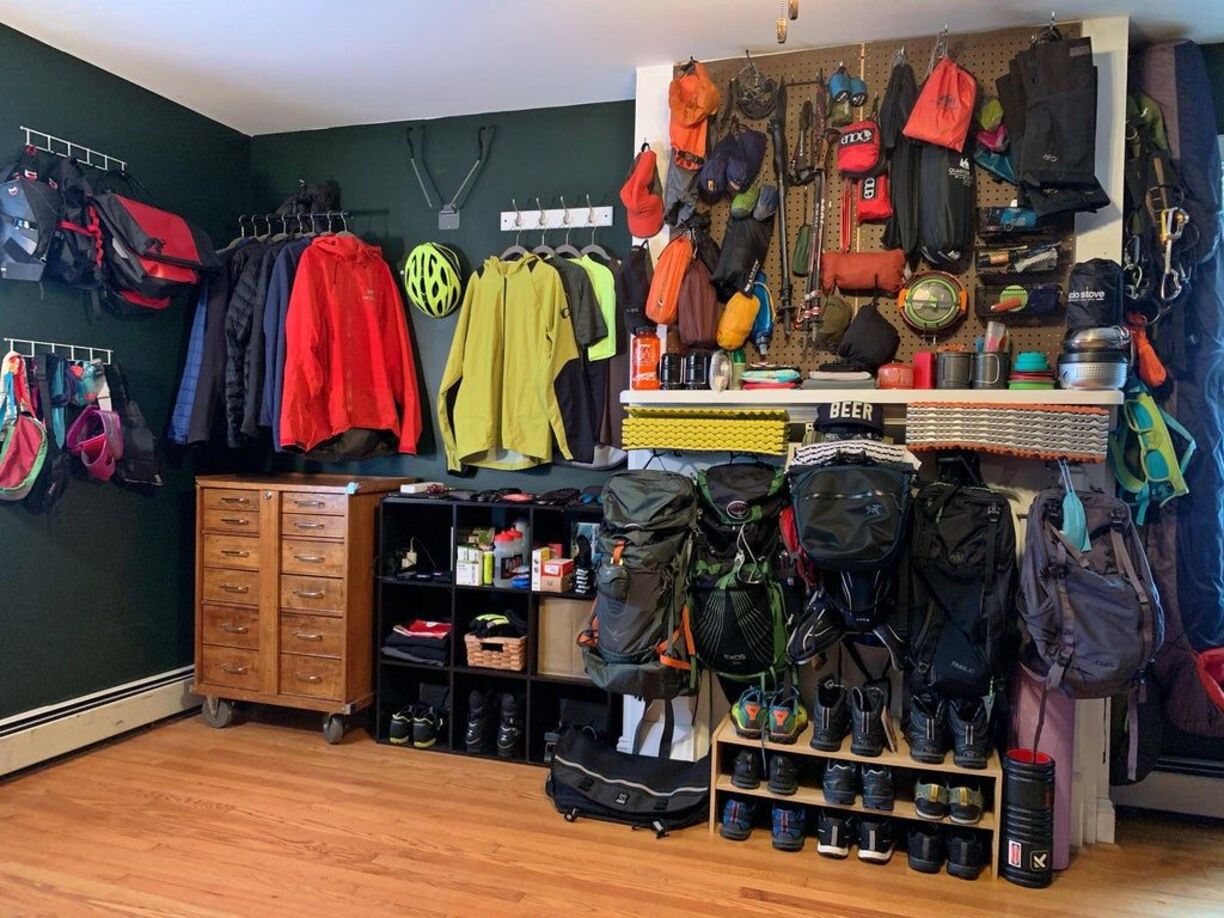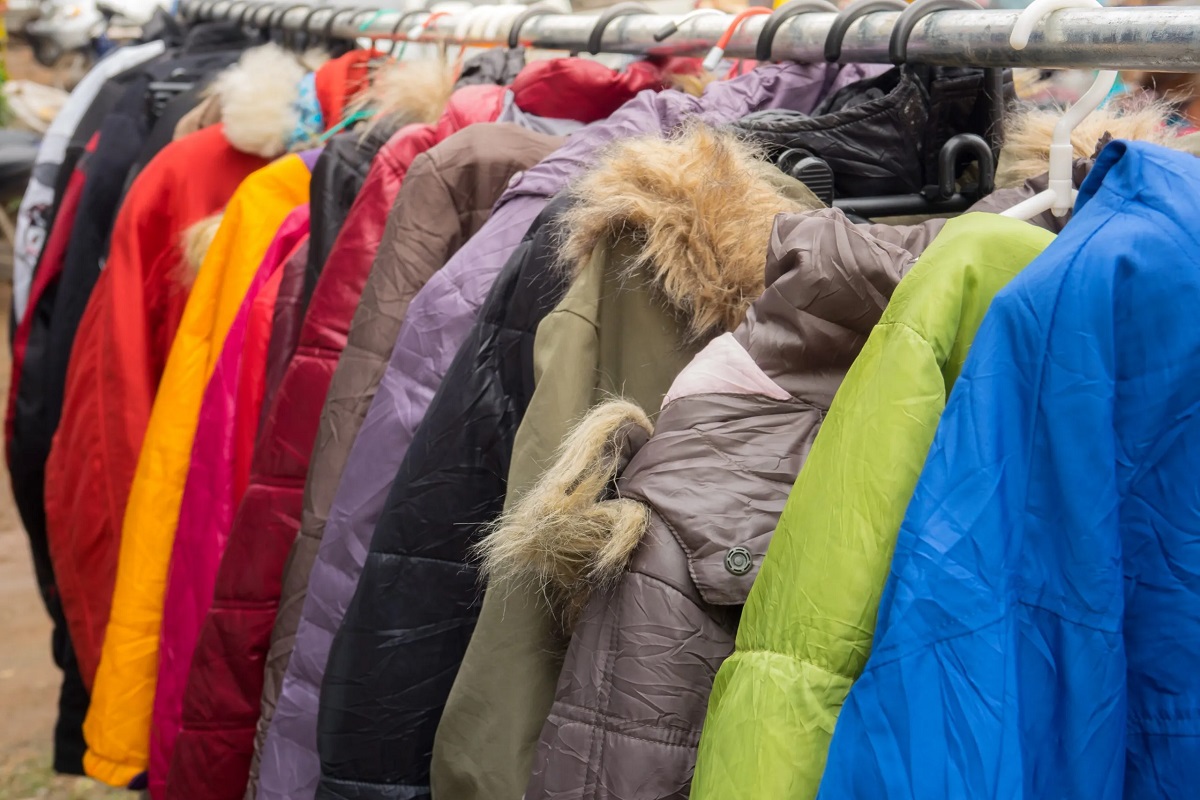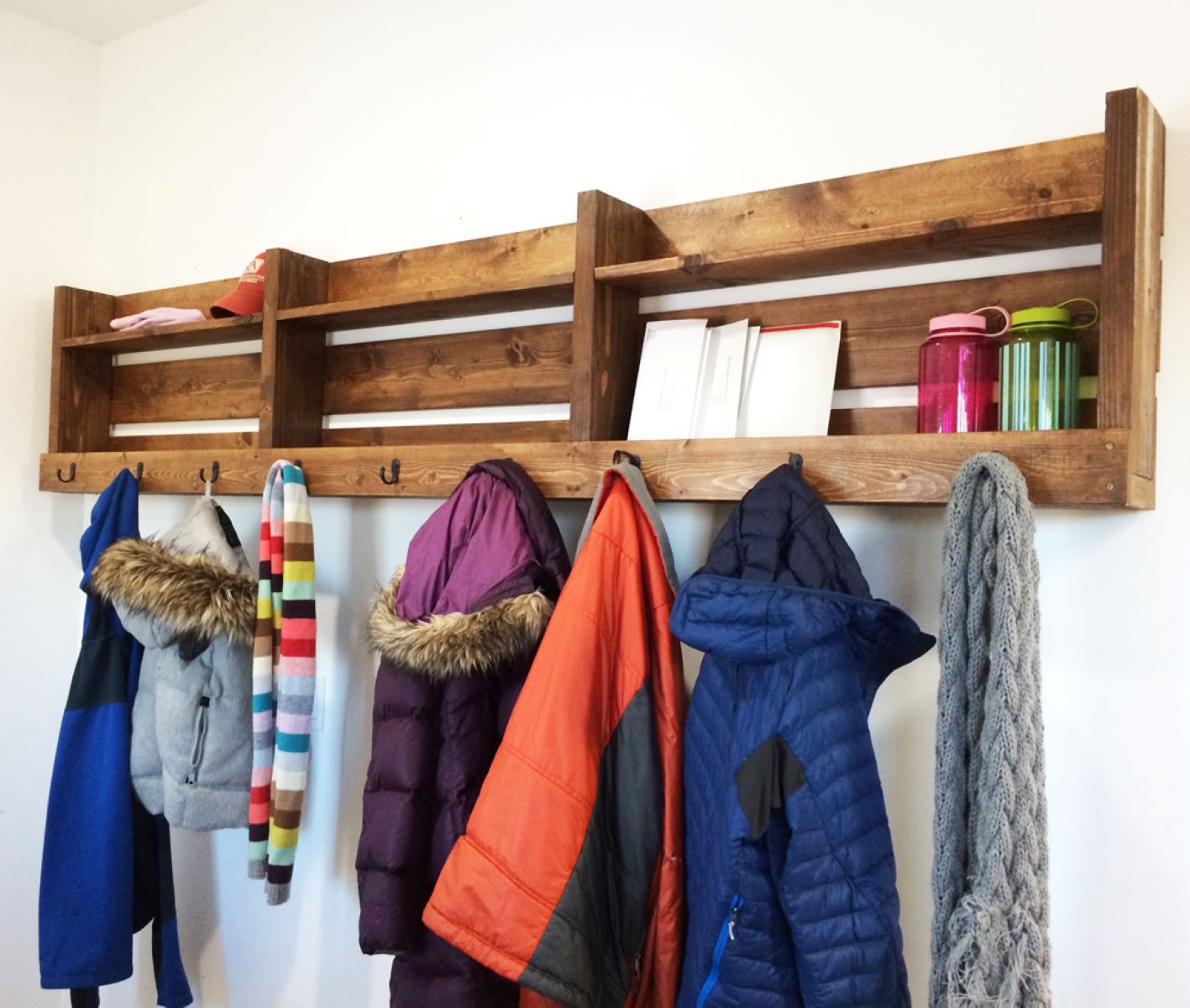

Articles
How To Store Winter Clothing
Modified: February 27, 2024
Learn how to store your winter clothing properly to keep them in good condition for next year. Check out our articles for helpful tips and tricks.
(Many of the links in this article redirect to a specific reviewed product. Your purchase of these products through affiliate links helps to generate commission for Storables.com, at no extra cost. Learn more)
Introduction
As the colder months come to an end and spring approaches, it’s time to say goodbye to your winter clothing and prepare for the warmer days ahead. However, storing your winter clothing properly is crucial in ensuring their longevity and keeping them in good condition until the next winter season. Whether you have a small closet or ample storage space, choosing the right storage method and taking proper care of your winter clothes is essential.
In this article, we will guide you through the process of storing your winter clothing effectively. From cleaning and preparing your winter clothes to sorting and organizing them, we will explore various storage methods that will help keep your winter wardrobe safe and well-maintained. We will also provide tips on protecting your winter boots and shoes, as well as storing your winter clothing during the off-season.
By following these tips and suggestions, you can ensure that your winter clothing remains in top-notch condition, ready to be taken out and worn again when winter arrives. So, let’s dive into the details and explore the best practices for storing winter clothing.
Key Takeaways:
- Properly storing winter clothing is essential for maintaining their condition and longevity, ensuring they’re ready to wear when the cold season returns. From choosing the right storage method to protecting delicate items, every step is crucial.
- Long-term winter clothing storage requires extra care, including using quality storage containers, climate-controlled storage, and monitoring for damage. By implementing these strategies, your winter wardrobe will remain fresh and ready for the next cold season.
Read more: How To Store Winter Boots
Choosing the Right Storage Method
When it comes to storing your winter clothing, there are several storage methods to consider. The choice of method depends on factors such as available space, the type of clothing, and personal preference. Let’s take a look at some of the most popular storage methods:
- Closets: If you have enough closet space, this can be an ideal option for storing your winter clothing. Separate your winter clothes from your regular clothes and hang them up in your closet. This allows for easy access and helps prevent wrinkles.
- Drawers: Utilizing drawers can be a convenient way to store smaller winter items like scarves, gloves, and hats. Fold or roll them neatly and place them in designated drawers.
- Vacuum Storage Bags: Vacuum storage bags are great for maximizing space. Place your winter clothing inside the bag, seal it, and use a vacuum cleaner to remove the air and compress the items. This method is especially useful for bulky winter garments like coats and sweaters.
- Storage Bins: Clear plastic storage bins with lids are a popular choice for storing winter clothing. Make sure the bins are clean and dry before placing your clothes inside. Label the bins for easy identification when you need to retrieve them.
- Garment Bags: Garment bags are perfect for storing delicate and formal winter clothing. Hang your coats, dresses, and suits inside the bags to keep them protected from dust and potential damage.
When choosing a storage method, consider factors such as accessibility, protection from dust and moisture, and the amount of space you have available. It’s also important to assess the specific storage requirements of your winter clothing to determine the most suitable method.
Now that we’ve explored the different storage methods, let’s move on to the next step: cleaning and preparing your winter clothes for storage.
Cleaning and Preparing Winter Clothes
Before storing your winter clothing, it’s essential to clean them properly to remove any dirt, stains, or odors that may have accumulated during the winter season. Here are some steps to follow when cleaning and preparing your winter clothes for storage:
- Read the Care Labels: Check the care labels on your winter clothing to determine the appropriate cleaning method. Some items may require hand washing, while others can be machine washed or dry cleaned.
- Wash or Dry Clean: Follow the recommended cleaning method for each item. If machine washing, use a gentle cycle, cold water, and a mild detergent. For delicate items, consider using a mesh laundry bag to protect them.
- Remove Stains: Treat any stains before washing. Use a stain remover or a solution of water and gentle detergent to gently blot the stained area. Avoid rubbing the stain, as it can cause further damage.
- Dry Thoroughly: Ensure that your winter clothes are completely dry before storing them. Hang them up or lay them flat on a clean surface until they are fully dry. Avoid storing damp or moist clothing, as it can lead to mold and mildew growth.
- Mend Any Damage: Inspect your winter clothing for any tears, loose buttons, or other damages. Repair or mend them before storing to prevent further deterioration.
Once your winter clothes are clean and in good condition, it’s time to move on to the next step: sorting and organizing them.
Sorting and Organizing Winter Clothing
Sorting and organizing your winter clothing will not only make it easier to find specific items when you need them but also help keep your storage space neat and efficient. Here are some tips for sorting and organizing your winter clothing:
- Sort by Category: Start by categorizing your winter clothing. Group similar items together, such as sweaters, jackets, pants, and accessories like scarves and hats. This will make it easier to locate specific pieces when you want to retrieve them.
- Purge Unused Items: Take this opportunity to declutter your winter wardrobe. Get rid of any items that you no longer wear or need. Donate them to charity or sell them if they’re still in good condition.
- Use Dividers or Organizers: Within each category, use dividers or organizers to further separate different types of clothing. This can be done with drawer dividers, shelf dividers, or hanging organizers. It will help keep everything neatly separated and easily accessible.
- Consider Seasonal Rotation: If you have limited storage space, consider rotating your clothing based on the season. Keep your most frequently used winter items easily accessible, while stowing away those that you won’t need until later in the season.
- Label or Color-Code: Label your storage bins, drawers, or garment bags to identify the contents. You can also color-code your storage containers based on different categories, making it even easier to find what you need at a glance.
By sorting and organizing your winter clothing in a systematic manner, you’ll be able to maintain order and make the most of your storage space. Now let’s explore different storage methods for winter clothing.
Storing Winter Clothing in Closets
If you have enough closet space, storing your winter clothing in closets can be a convenient option. Here are some tips for effectively storing your winter clothing in closets:
- Clean the Closet: Before storing your winter clothes, clear out any clutter in your closet and give it a thorough cleaning. Wipe down the surfaces and vacuum the floor to remove any dust or debris.
- Separate Winter and Summer Clothes: If you have a separate closet for seasonal clothing, it’s best to keep your winter and summer clothes separated. This will make it easier to find what you need when the seasons change.
- Hang Heavy Items: Hang heavy winter coats and jackets on sturdy hangers to prevent them from losing their shape. Use padded hangers for delicate or structured garments to avoid stretching or damaging them.
- Utilize Hanging Organizers: Consider using hanging organizers or shoe racks to utilize vertical space in your closet. You can use them to store scarves, belts, hats, and other winter accessories.
- Keep Boots and Shoes Organized: Use boot shapers or rolled-up magazines to maintain the shape of your boots. Place them on a shoe rack or shelf to keep them organized and easily accessible.
- Store Sweaters Properly: Instead of hanging sweaters, which can cause them to stretch, fold them neatly and store them in stackable storage bins or on designated shelves. Avoid using wire bins or plastic bags, as they can trap moisture and lead to damage.
- Protect Delicate Items: For delicate winter clothing such as evening gowns or suits, consider using garment bags to protect them from dust and potential damage. Choose breathable bags made of fabric or use acid-free garment covers for long-term storage.
- Arrange by Frequency of Use: Organize your winter clothing in a way that makes it easy to access the items you’ll need most frequently. Place frequently worn pieces at the front of the closet, while lesser-used items can be stored towards the back.
By following these tips, you can maximize your closet space and keep your winter clothing well-organized and accessible for the next cold season. Next, let’s explore another storage option: storing winter clothing in drawers.
Read more: How To Store Winter Shoes
Storing Winter Clothing in Drawers
Utilizing drawers can be an efficient way to store smaller winter items and accessories. Here are some tips for storing your winter clothing in drawers:
- Clean and Line the Drawers: Clean the drawers thoroughly before storing your winter clothes. Wipe down the surfaces and consider lining the drawers with drawer liners or fabric to protect your clothing and keep them fresh.
- Fold Neatly: Fold your winter clothing carefully to minimize wrinkles and save space. Consider using a folding board or template for consistent folding. Stack similar items together, such as sweaters, leggings, or thermal tops, to keep them organized.
- Separate with Dividers: Use dividers or drawer organizers to separate different types of clothing within the drawer. This will make it easier to locate specific items without creating a mess. Consider using adjustable dividers to customize the space according to your needs.
- Roll Specialty Items: For items like scarves, gloves, and beanies, consider rolling them up and storing them in small bins or compartments within the drawer. This method saves space and allows for easy visibility and access to these accessories.
- Organize by Layer: If you have deep drawers, organize your winter clothing in layers. Place less frequently used items at the bottom and more frequently worn items on top. This will prevent the need to dig through the entire drawer when you only want to access a specific piece.
- Utilize Drawer Dividers: Drawer dividers can be especially useful for organizing socks, underwear, and other small items. Assign specific compartments for each category, ensuring that everything has its designated place.
- Avoid Overstuffing: Be mindful not to overstuff your drawers, as it can lead to wrinkles and damage to your clothing. Leave some space for air circulation, which can help prevent moisture buildup.
- Label or Color-Code: To make finding specific items even easier, consider labeling or color-coding your drawers. This will allow you to quickly locate the item you need without rummaging through the entire drawer.
By following these tips, you can keep your winter clothing neatly organized and easily accessible in drawers. Let’s continue by exploring the option of using vacuum storage bags for storing winter clothing.
Using Vacuum Storage Bags
Vacuum storage bags are an excellent choice for maximizing space and compressing bulky winter clothing. Here’s how you can effectively use vacuum storage bags for storing your winter clothing:
- Sort and Fold: Before placing your clothes in the vacuum storage bags, sort them into categories and fold them neatly. This not only helps save space in the bags but also prevents wrinkles.
- Place in Bags: Insert your folded winter clothing into the vacuum storage bags. Be careful not to overstuff the bags, as it may prevent proper air removal or result in a burst bag.
- Seal the Bags: Once all your clothing is inside the bags, seal them tightly. Most vacuum storage bags come with a built-in zipper or slide-seal closure. Ensure that the seal is secure and airtight.
- Remove Air: Use a vacuum cleaner to remove the air from the bags. Start by attaching the vacuum cleaner nozzle to the designated valve on the bag. Turn on the vacuum cleaner and watch as the bag compresses, sucking out the excess air.
- Store the Bags: Once the air is removed, quickly seal the valve on the bag to prevent air from entering. The compressed bags can now be placed in closets, under the bed, or in any storage area with limited space.
- Avoid Sharp Objects: While vacuum storage bags are durable, it’s important to handle them with care. Avoid placing sharp objects or rough-edged clothing items that could potentially puncture the bag.
- Protect Delicate Fabrics: For delicate fabrics that require extra care, consider placing them in a protective garment bag or wrapping them in tissue paper before placing them inside the vacuum storage bag. This will provide an additional layer of protection against wrinkles and damage.
- Use Desiccant Packs: To prevent moisture buildup inside the vacuum storage bags, place desiccant packs or moisture-absorbing products inside before sealing. This will help keep your clothing dry and free from potential mold or mildew.
Using vacuum storage bags can significantly reduce the volume of your winter clothing, making them easier to store and saving valuable space. However, it’s important to note that vacuum storage bags may not be suitable for garments made of delicate or structured materials, such as fur coats or tailored suits. For these items, it’s best to explore other storage options.
Now that we’ve covered vacuum storage bags, let’s move on to utilizing storage bins for storing winter clothing.
Store winter clothing in a cool, dry place away from direct sunlight to prevent fading and damage. Use breathable storage containers or garment bags to protect items from dust and moisture.
Utilizing Storage Bins
Storage bins are a popular choice for organizing and storing winter clothing. Here are some tips for effectively utilizing storage bins:
- Select the Right Bins: Choose sturdy and durable plastic storage bins with secure lids. Opt for clear bins to easily identify the contents without having to open each one.
- Clean and Dry the Bins: Before placing your clothing in the bins, ensure that they are clean and dry. Wipe down the bins with a damp cloth and let them air dry to avoid any moisture buildup.
- Sort and Categorize: Sort your winter clothing into categories, such as sweaters, coats, or accessories. Place each category in a separate bin to keep things organized.
- Fold Objects Neatly: Fold your clothing items neatly to maximize space and prevent wrinkling. Take care when folding bulky items like puffy jackets to ensure they fit into the bins without being overly compressed.
- Label the Bins: Use adhesive labels or write directly on the bins to identify the contents. This will make it easier to locate specific items when you need them without having to open every bin.
- Stack the Bins Sistematically: If you have multiple bins, stack them in a systematic manner. Place heavier bins at the bottom and lighter ones on top to ensure stability. Keep frequently used items within reach by placing their bins on the top of the stack.
- Utilize Vertical Space: Make use of vertical space within the bins by utilizing dividers or small bins for storing smaller items like socks or accessories. This will help maximize the space and keep everything organized.
- Store in a Cool and Dry Area: Find a cool and dry area in your home to store the bins. Avoid areas that are prone to moisture or extreme temperature changes, as they can damage your clothing. A basement or a dry closet can be a suitable location.
- Check and Rotate Periodically: Periodically check on your stored winter clothing to ensure they are in good condition. Rotate the bins to prevent any potential long-term bending or damage to the clothing inside.
By utilizing storage bins, you can keep your winter clothing organized, protected, and easily accessible when needed. Next, let’s explore another option for storing winter clothing – hanging them in garment bags.
Hanging Winter Clothing in Garment Bags
Hanging your winter clothing in garment bags can be an excellent option for storing delicate or formal items. Here are some tips for effectively hanging winter clothing in garment bags:
- Choose the Right Garment Bags: Select garment bags made of breathable fabric, such as cotton or canvas, to allow air circulation and prevent moisture buildup. Clear bags are useful for easily identifying the contents.
- Clean and Dry the Clothing: Ensure that your winter clothing is clean and completely dry before placing them in the garment bags. Storing dirty or damp clothes can lead to mold and mildew growth.
- Hang on Sturdy Hangers: Use sturdy and wide hangers to support the weight of your winter clothing. Avoid using wire hangers, as they can cause creases or misshapen shoulders.
- Zip Up the Garment Bags: Once your clothing is properly hung, zip up the garment bags completely. This will provide protection from dust, insects, and potential damage.
- Separate with Tissue or Acid-Free Paper: For delicate or structured items like dresses or suits, consider placing acid-free tissue paper or garment covers between layers to prevent any potential friction or damage.
- Organize by Occasion or Season: Separate your winter clothing in garment bags based on occasions or seasons. For example, you can have a separate garment bag for formal attire, business wear, or casual winter clothes.
- Hang in a Cool and Dry Area: Find a suitable location in your home to hang the garment bags. Choose a cool and dry area away from direct sunlight and extreme temperature changes.
- Inspect and Maintain Regularly: Check on your winter clothing periodically to ensure they are in good condition. Remove any potential wrinkles or vacuum out any accumulated dust inside the garment bags.
- Rotate Usage: Rotate the usage of your winter clothing by alternating the garments you hang. This helps prevent misshaping or creasing that can occur from being hung for too long.
By hanging your winter clothing in garment bags, you can keep them protected, easily accessible, and well-preserved for the next winter season. Now that we’ve explored various storage methods, let’s move on to discuss storing winter outerwear and accessories.
Read more: How To Store Winter Hats
Storing Winter Outerwear and Accessories
When it comes to storing winter outerwear and accessories, such as coats, boots, and hats, a different approach is often needed due to their bulkier nature. Here are some tips for storing winter outerwear and accessories:
- Clean and Dry: Before storing your winter outerwear, ensure that they are clean and completely dry. This will prevent any lingering dirt or moisture from causing damage during storage.
- Coats and Jackets: Hang coats and jackets on sturdy hangers in a cool, dry area. If possible, use wide hangers to support the shoulders and maintain their shape.
- Boots and Shoes: Clean and dry your winter boots and shoes thoroughly. Stuff them with acid-free paper or boot shapers to help maintain their shape while in storage. Place them in a designated area, such as a shoe rack or a boot tray.
- Hats, Scarves, and Gloves: Store hats, scarves, and gloves in designated containers or bins. Keep similar items together and label the containers for easy identification. Consider using breathable fabric or cotton bags to protect delicate accessories.
- Down Jackets and Puffy Coats: For down jackets and puffy coats, avoid compressing them too much, as it can affect their insulation. Store them in breathable garment bags or oversized storage bags that allow them to retain their natural loft.
- Fur and Leather Items: Fur and leather items require specialized storage. Avoid exposing them to direct sunlight or extreme temperatures. Store them in climate-controlled areas, such as a fur storage facility or a cool, dark closet.
- Dealing with Mold and Mildew: If you’ve encountered mold or mildew on any of your winter outerwear or accessories, make sure to clean the affected items thoroughly before storing them. Use a mixture of mild detergent and water to clean the surface and allow them to dry completely before storage.
- Rotate Usage and Inspect Regularly: Rotate the usage of your winter outerwear and accessories to prevent prolonged compression and to ensure even wear. Regularly inspect stored items for any signs of damage or pests.
- Utilize Space-Saving Solutions: Consider using space-saving solutions, such as vacuum storage bags, to compress bulky winter outerwear like comforters or heavy blankets. This can free up valuable closet or storage space.
By following these guidelines, you can ensure that your winter outerwear and accessories remain in good condition and are ready to use when the colder months return. Now, let’s move on to discuss how to protect your winter boots and shoes during storage.
Protecting Winter Boots and Shoes
Properly protecting your winter boots and shoes during storage is essential in preserving their quality and ensuring they’re ready to wear when the cold season arrives again. Here are some tips to help you protect your winter footwear:
- Clean and Dry: Thoroughly clean your winter boots and shoes before storing them. Remove any dirt, salt residue, or stains using a soft brush or damp cloth. Ensure they are completely dry to prevent mold or mildew growth.
- Condition Leather Boots: For leather boots, apply a leather conditioner or moisturizer to keep the leather soft and prevent it from cracking or drying out during storage.
- Remove Insoles and Inserts: Take out the insoles and inserts from your winter boots and shoes. This allows them to dry properly and prevents any potential odor or bacteria buildup.
- Protect from Dust and Moisture: Place your winter boots and shoes in individual dust bags or fabric shoe covers to protect them from dust and potential damage. Avoid using plastic bags, as they can trap moisture and lead to mold or mildew.
- Store in a Cool and Dry Place: Find a cool, dry area for storing your winter footwear. Avoid areas that are prone to high humidity, extreme temperature changes, or direct sunlight, as they can cause damage to the materials.
- Stack Boots Properly: If you need to stack your boots, avoid placing heavy items on top of them, as this can cause deformation or creasing. Use boot shapers or rolled-up newspapers to keep the shape of the boots intact.
- Avoid Floor Contact: Keep your boots off the floor to prevent any potential damage or moisture absorption. Use shoe racks, shelves, or boot trays to provide proper support and keep them elevated.
- Consider Silica Gel Packs: Place silica gel packs or moisture-absorbing products near your stored boots and shoes to help prevent moisture buildup. This can help protect against mold and mildew.
- Rotate Usage: Rotate the usage of your boots and shoes during the winter season to prevent excessive wear on a single pair. This will also allow you to properly clean and dry the footwear before storing them for an extended period.
- Regularly Inspect: Periodically inspect your winter boots and shoes during storage to ensure they are in good condition. Look for any signs of damage, such as loose soles or cracks, and address them promptly to prevent further deterioration.
By following these practical tips, you can protect your winter boots and shoes, keeping them in great condition for the next cold season. Now, let’s discuss the storage of winter clothing during the off-season.
Storing Winter Clothing in Off-Season
When the winter season comes to an end, it’s time to store your winter clothing to make space for your spring and summer wardrobe. Here are some tips for storing winter clothing during the off-season:
- Clean and Repair: Before storing your winter clothing, make sure they are clean and free from any stains or dirt. Mend any rips or tears to prevent further damage during storage.
- Choose the Right Location: Select a suitable location to store your winter clothing. Ideally, it should be a cool, dry, and well-ventilated area, such as a closet, attic, or basement. Avoid areas with high humidity or extreme temperature fluctuations.
- Use Protective Covers: Place your winter clothing in fabric garment bags or breathable storage bags to protect them from dust, insects, and potential damage. Alternatively, you can also use acid-free tissue paper or cotton sheets to wrap individual items before storing.
- Consider Climate-Controlled Storage: If you live in an area with high humidity or changing climate conditions, consider using a climate-controlled storage unit for your winter clothing. This provides an optimal environment to prevent moisture buildup and mold growth.
- Avoid Plastic Bags: While it may be tempting to use plastic bags for storage, they can trap moisture and lead to mold or mildew. Opt for breathable storage options to allow air circulation and prevent damage to your clothing.
- Separate Delicate Items: If you have delicate or special garments, such as cashmere sweaters or silk dresses, store them separately to avoid any potential snagging or damage from other items.
- Pack Neatly: Fold your winter clothing neatly to conserve space and prevent wrinkles. Avoid overpacking storage containers to allow proper air circulation and maintain the condition of your clothing.
- Label and Organize: Label your storage containers or garment bags to easily identify the contents. Categorize your winter clothing by type or occasion to make it easier to find specific items when the next winter season arrives.
- Monitor Regularly: Periodically check on your stored winter clothing to ensure they remain in good condition. Inspect for any signs of moisture, pests, or damage. Address any issues promptly to prevent further problems.
- Rotate Storage: Consider rotating your storage containers or garment bags during the off-season. This helps distribute weight and allows for even wear and tear on the storage materials.
By following these guidelines, you can ensure that your winter clothing remains in optimal condition during the off-season and is ready to be worn again when the colder months return. Now, let’s explore some tips for long-term winter clothing storage.
Tips for Long-Term Winter Clothing Storage
Long-term storage requires extra care to ensure your winter clothing remains in excellent condition. Here are some tips for long-term winter clothing storage:
- Thoroughly Clean and Dry: Before storing your winter clothing for an extended period, make sure they are thoroughly cleaned and completely dry. Lingering dirt or moisture can lead to mold, mildew, or unpleasant odors.
- Invest in Quality Storage Containers: Use high-quality storage containers or garment bags to protect your winter clothing during long-term storage. Look for options that are breathable and help maintain the integrity of your garments.
- Avoid Moth Damage: To prevent damage from moths and other pests, consider using natural moth repellents, such as lavender sachets or cedar balls, in your storage containers. Avoid mothballs, as they contain harsh chemicals that can be harmful to your clothing.
- Choose Climate-Controlled Storage: If possible, opt for a climate-controlled storage unit to protect your winter clothing from extreme temperature fluctuations and humidity. This helps maintain the quality of your garments over long periods.
- Inspect for Damage: Before storing your winter clothing for long-term storage, inspect each item for any signs of damage. Repair any loose buttons, small tears, or loose seams to prevent further deterioration.
- Use Acid-Free Tissue Paper: Place acid-free tissue paper between folded garments to prevent color transfer and creasing. This helps maintain the shape and condition of your winter clothing while in storage.
- Rotate Storage Containers: If you have the space, consider rotating your storage containers periodically. This helps distribute weight and pressure, ensuring that your clothing remains in good condition throughout the storage period.
- Avoid Direct Sunlight: Store your winter clothing in a location away from direct sunlight. Prolonged exposure to sunlight can cause fading and discoloration of fabrics over time.
- Utilize Silica Gel Packs: Place silica gel packs or moisture-absorbing products in your storage containers to prevent excess moisture buildup. This helps protect your clothing from mold, mildew, and musty odors.
- Monitor and Refresh: Periodically check on your stored winter clothing and refresh the storage environment. Remove garments, inspect for any issues, and allow them to air out before returning them to storage.
- Avoid Heavy Stacking: If you need to stack storage containers, avoid placing heavy items on top of delicate garments. Heavy pressure over a long period can cause damage or permanent creasing.
- Document and Track: Consider creating an inventory of your stored winter clothing. This can help you keep track of what you have and where it’s stored. Digital photos or a written journal can serve as a reference.
By following these tips, you can ensure that your winter clothing remains in excellent condition throughout long-term storage. Now we can conclude our discussion on proper winter clothing storage.
With the right storage method, cleanliness, organization, and maintenance, you can keep your winter clothing fresh, protected, and ready to wear when the colder seasons return. Follow these guidelines to ensure that your winter wardrobe stays in top-notch condition, and you’ll be well-prepared to bundle up and stay stylish during the next winter season.
Happy storing!
Read more: How To Store Winter Clothes
Conclusion
Properly storing your winter clothing is crucial for maintaining their condition and ensuring they’re ready to wear when the cold season rolls around again. Whether you have limited space or ample storage options, there are various methods to store your winter wardrobe effectively.
By following the tips and guidelines provided in this article, you can ensure that your winter clothing remains clean, protected, and well-organized throughout storage. From choosing the right storage method to cleaning and preparing your winter clothes, sorting and organizing them, and utilizing various storage solutions, every step is important in maintaining the longevity of your winter wardrobe.
Closets, drawers, vacuum storage bags, storage bins, and garment bags all offer distinct advantages depending on the type of clothing and available space. Additionally, taking extra precautions to protect delicate items, winter boots and shoes, and properly storing them during the off-season contribute to preserving their quality.
Long-term winter clothing storage requires specific considerations, including using quality storage containers, climate-controlled storage units, and implementing measures to prevent damage from pests, moisture, and sunlight. Regular monitoring, inspecting for any damage, and refreshing the storage environment are essential for the long-term preservation of your winter clothing.
By implementing these strategies and incorporating them into your storage routine, you can ensure that your winter clothing maintains its quality, staying fresh and ready to be worn again when the colder months return. Not only will your winter wardrobe be protected, but you’ll also save time and effort in preparing for the next winter season.
Remember, keeping your winter clothing in optimal condition is the key to maximizing their lifespan and enjoying the warmth and style they provide. With proper storage, your winter clothing will be waiting for you, ready to keep you cozy and fashionable when the temperature drops once again.
So, take the time to follow these storage tips and techniques, keep your winter clothing in top shape, and bid farewell to the cold season with confidence, knowing that your wardrobe is well taken care of.
Happy storing!
Frequently Asked Questions about How To Store Winter Clothing
Was this page helpful?
At Storables.com, we guarantee accurate and reliable information. Our content, validated by Expert Board Contributors, is crafted following stringent Editorial Policies. We're committed to providing you with well-researched, expert-backed insights for all your informational needs.













0 thoughts on “How To Store Winter Clothing”